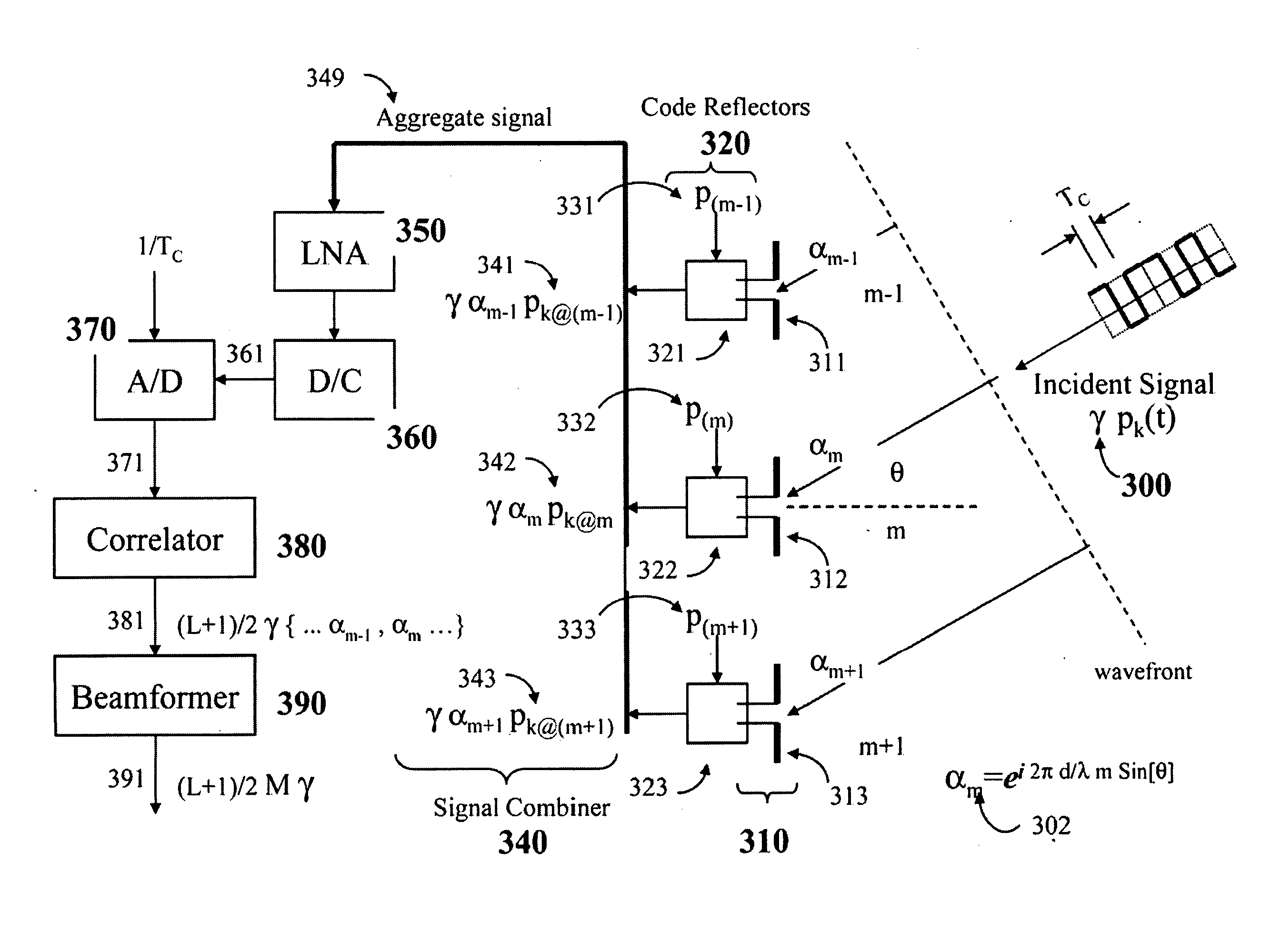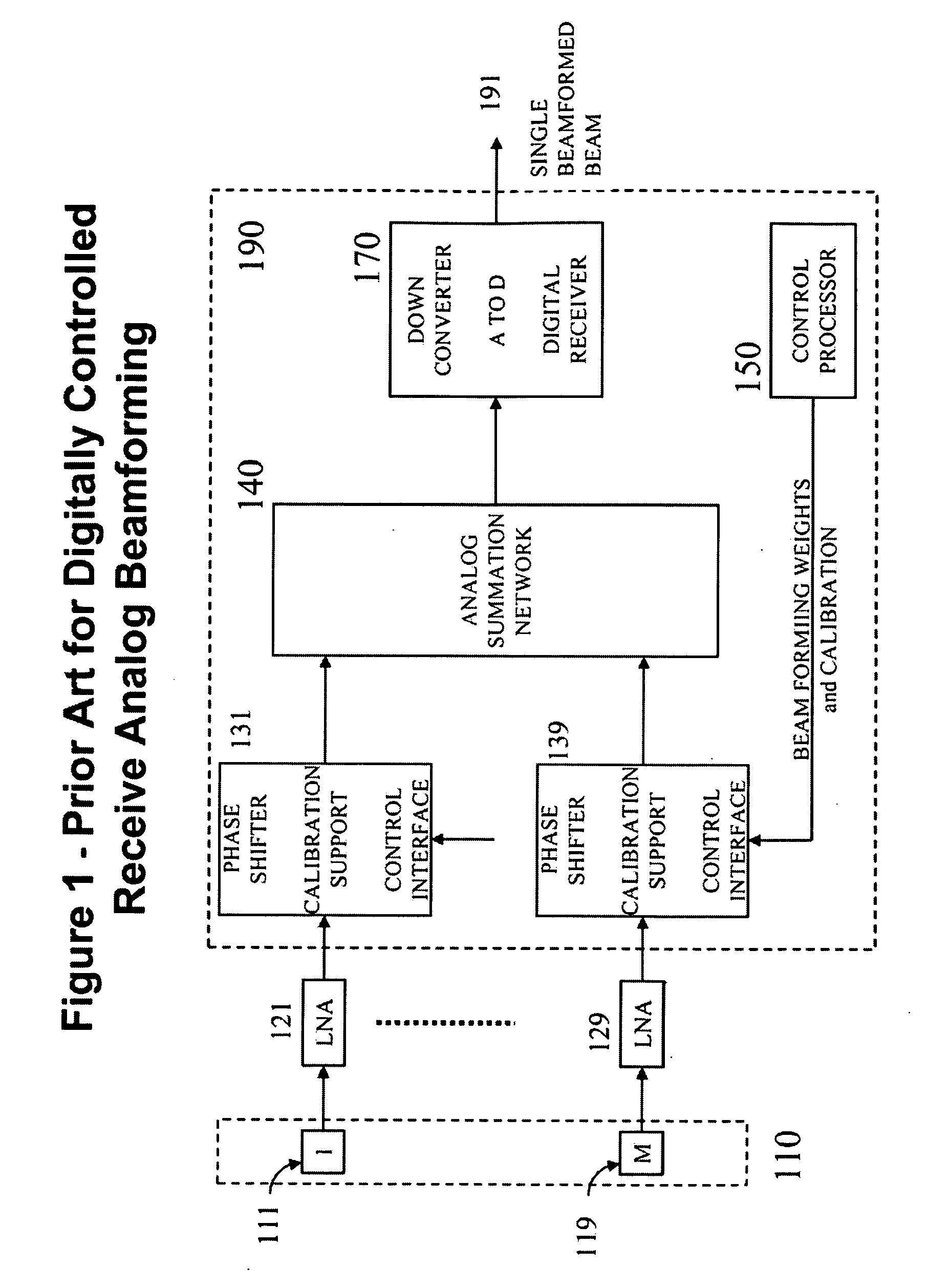[0010]The overall object of this invention is an array antenna with digital
beamforming capabilities that uses a single transceiver with one
low noise amplifier (LNA) / one power amplifier (PA), one up / down frequency converter and one pair of analog-to-digital and digital-to-analog converters for the entire array. The spread spectrum beamformer method performs the
multiplexing of signals to / from each
array element with minimum hardware at the array elements and enables the implementation of array antennas with digital beamforming capabilities that are thin and scales large arrays and to high frequencies.
[0011]Accordingly, the method object of this invention applies to radars, sensors and communication systems equipped with array antennas. One aspect that differentiates this invention from prior art as applied to digital beamforming is the method of using direct-sequence spread spectrum for both transmission and multiplexing inside arrays with spaced apart array elements. This enables digital beamforming with capability and performance comparable to or better than array antennas using prior art digital beamforming technologies with the
advantage that, contrary to prior art, the array antennas DO NOT require a digital transceiver including LNA / PA, up / down frequency converter and analog-to-digital / digital-to-analog converters at each
array element or sub-array and, as a result, are simpler to design, manufacture and test; scale up in frequency and in number of elements;
scale down in power, weight, thickness and heat dissipation.
[0014]It is an object of this invention that, when receiving, incident signals at each element are enabled to be multiplexed directly at the frequencies in which they are received, and then extracted without mutual interference while being subject to negligible
noise-relate performance degradation. This enables the implementation of low-profile receive array antennas as the
low noise amplifier and the digital
receiver electronics including down-converter and analog-to-
digital converter can be placed remotely from the actual
antenna array elements.
[0020]The receive
system includes a receive array apparatus integrated with a method for generating direct-sequence spread spectrum signals comprised of a multitude of pseudo-
noise sequences with a
common base sequence including maximal-length sequences with different cyclic shifts, and a method for receiving such spread spectrum signals from different positions including a multiplicity of transmitters at different locations while subjected to reflections from stationary obstacles and moving objects; generating reflected signals at the same carrier frequency as the incident signal while using reflecting signals with distinguishable spectrum features at each
array element; combining such reflected signals into a common aggregate radio-frequency signal for the array using either wired or
wireless means; converting the aggregate radio-frequency signal to a convenient
intermediate frequency including
baseband while using a single
low noise amplifier and down-converter for the entire array; sampling the resulting aggregate
baseband signal while using a single analog-to-
digital converter operating at least at the Nyquist rate of the received signals; correlating such an aggregated
baseband signal against sequences or variations thereof included in the aggregate radio-frequency signal while capturing angle-of-arrival and multipath information and achieving spread spectrum
processing gain and multipath
gain; and performing joint beamform and detection to estimate signals, data or parameters included in the incident signals including spatial nulling of a subset of such incident signals while achieving receive
array gain. The resulting receive system apparatus and methods enable receive digital beamforming with capability and performance comparable to or better than receive arrays using prior art digital beamforming technologies with the
advantage that, contrary to prior art, they DO NOT require a digital transceiver including LNA, down-converter and analog-to-digital converter at each element and, as a result, are simpler to design, manufacture and test; scale up in frequency and number of elements;
scale down in power, weight, thickness and heat dissipation.
[0021]The transmit system includes a
transmit array apparatus integrated with a spread spectrum multiplexing method for generating, aggregating, up-converting, amplifying, distributing and extracting a beamforming radio-frequency signal for each element of the array, a method for re-modulating the radio-frequency signal extracted at each element including corresponding beamforming weight as a direct-sequence spread spectrum signal while using codes that can be equal or different for each element, including codes comprising a pseudo-noise sequence with a different
cyclic shift from a
common base sequence including a maximal-length sequence, and a method for generating, amplifying and transmitting such extracted radio-frequency signals including resulting re-modulated spread spectrum signals as a sequence of short-duration high-power pulses while using a power amplification method comprised of passive components that combines segmenting a continuous radio-frequency signal in equal-duration wave-blocks, coherently accumulating the energy of each wave-block in a
delay line, and then releasing the coherently accumulated energy as short-duration pulse per wave-block while achieving
array gain and further
bandwidth expansion as compared to the bandwidth of the original signal distributed to or generated at each element of the array. The resulting transmit system apparatus and methods enable transmit digital beamforming with capability and performance including
radar-related time-and-frequency
ambiguity resolution performance comparable to or better than transmit arrays using prior art digital beamforming technologies with the
advantage that, contrary to prior art, they DO NOT require a digital transceiver including power amplifier, up-converter and digital-to-analog converter at each element and, as a result, are simpler to design, manufacture and test; scale up in frequency and number of elements; scale down in power, weight, thickness and heat dissipation.
 Login to View More
Login to View More  Login to View More
Login to View More 


